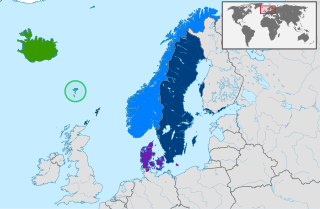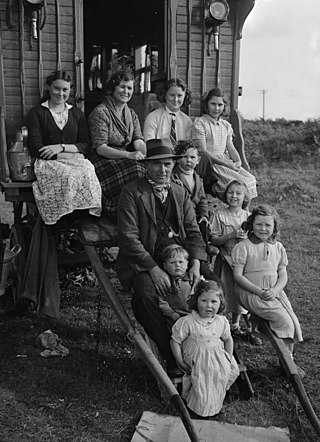
Norwegian is a North Germanic language spoken mainly in Norway, where it is an official language. Along with Swedish and Danish, Norwegian forms a dialect continuum of more or less mutually intelligible local and regional varieties; some Norwegian and Swedish dialects, in particular, are very close. These Scandinavian languages, together with Faroese and Icelandic as well as some extinct languages, constitute the North Germanic languages. Faroese and Icelandic are not mutually intelligible with Norwegian in their spoken form because continental Scandinavian has diverged from them. While the two Germanic languages with the greatest numbers of speakers, English and German, have close similarities with Norwegian, neither is mutually intelligible with it. Norwegian is a descendant of Old Norse, the common language of the Germanic peoples living in Scandinavia during the Viking Age.

Demographic features of the population of Norway include population density, ethnicity, education level, health of the populace, economic status, religious affiliations and other aspects.

The North Germanic languages make up one of the three branches of the Germanic languages—a sub-family of the Indo-European languages—along with the West Germanic languages and the extinct East Germanic languages. The language group is also referred to as the Nordic languages, a direct translation of the most common term used among Danish, Faroese, Icelandic, Norwegian, and Swedish scholars and people.
Bokmål is one of the official written standards for the Norwegian language, alongside Nynorsk. Bokmål is by far the most used written form of Norwegian today, as it is adopted by 85% to 90% of the population in Norway. There is no countrywide standard or agreement on the pronunciation of Bokmål and the spoken dialects vary greatly.
Nynorsk is one of the two official written standards of the Norwegian language, the other being Bokmål. From 12 May 1885, it became the state-sanctioned version of Ivar Aasen's standard Norwegian language (Landsmål), parallel to the Dano-Norwegian written standard known as Riksmål. The name Nynorsk was introduced in 1929. After a series of reforms, it is still the written standard closer to Landsmål, whereas Bokmål is closer to Riksmål and Danish.
Riksmål is an unofficial written Norwegian language form or spelling standard, meaning the National Language, closely related and now almost identical to the dominant form of Bokmål, known as Moderat Bokmål.

Kvens are a Balto-Finnic ethnic minority in Norway. They are descended from Finnish peasants and fishermen who emigrated from the northern parts of Finland and Sweden to Northern Norway in the 18th and 19th centuries. In 1996, Kvens were granted minority status in Norway, and in 2005 the Kven language was recognized as a minority language in Norway.

There are two Norwegian language editions of Wikipedia: one for articles written in Bokmål or Riksmål, and one for articles written in Nynorsk or Høgnorsk. There are currently 624,113 articles on the Norwegian Wikipedia edition in Bokmål/Riksmål, and 168,914 articles on the Nynorsk edition.
Dano-Norwegian was a koiné/mixed language that evolved among the urban elite in Norwegian cities during the later years of the union between the Kingdoms of Denmark and Norway (1536/1537–1814). It is from this koiné that the unofficial written standard Riksmål and the official written standard Bokmål developed. Bokmål is now the most widely used written standard of contemporary Norwegian.
Modern Norwegian is the Norwegian language that emerged after the Middle Norwegian transition period (1350–1536) until and including today. The transition to Modern Norwegian is usually dated to 1525, or 1536, the year of the Protestant Reformation and the beginning of the kingdoms of Denmark–Norway (1537–1814). It can be further divided into Early Modern Norway (1536-1848) until the separation from Denmark, and Newer Modern Norwegian from then to now.

The Norwegian language conflict is an ongoing controversy in Norwegian culture and politics related to the written versions of Norwegian. From 1536/1537 until 1814, Danish was the standard written language of Norway due to the union of crowns with Denmark, in which time the Danish Empire was founded. As a result, the overall form of chosen modern written Norwegian and its leaning towards or away from Danish underpins controversies in anti-imperialistic nationalism, rural versus urban cultures, literary history, diglossia, spelling reform, and orthography.

Swedish is the official language of Sweden and is spoken by the vast majority of the 10.23 million inhabitants of the country. It is a North Germanic language and quite similar to its sister Scandinavian languages, Danish and Norwegian, with which it maintains partial mutual intelligibility and forms a dialect continuum. A number of regional Swedish dialects are spoken across the country. In total, more than 200 languages are estimated to be spoken across the country, including regional languages, indigenous Sámi languages, and immigrant languages.
The Norwegian and Swedish Romanisæl Travellers are a group or branch of the Romani people who have been resident in Norway and Sweden for some 500 years. The estimated number of Romanisael Travellers in Sweden is 65,000, while in Norway, the number is probably about 10,000.
Scandoromani is a North Germanic based Para-Romani language. It is spoken by the Scandinavian Romanisæl Travellers, a Romani minority community, in Norway, and formerly in Sweden.
Indigenous Norwegian Travellers are an ethnic minority group in Norway. They are a wandering people who once travelled by foot, with horse-drawn carts and with boats along the southern and southwestern coastline of Norway.

The Kale are a group of Romani people in Wales. Many claim to be descendants of Abram Wood, who was the first Rom to reside permanently and exclusively in Wales in the early 18th century, although Romanichal Travellers have appeared in Wales since the 16th century. Welsh Kale are almost exclusively found in Northwest Wales, specifically the Welsh-speaking areas. Romanichal Travellers inhabit South Wales and North East Wales.

Sámi languages, in English also rendered as Sami and Saami, are a group of Uralic languages spoken by the Sámi people in Northern Europe. There are, depending on the nature and terms of division, ten or more Sami languages. Several spellings have been used for the Sámi languages, including Sámi, Sami, Saami, Saame, Sámic, Samic and Saamic, as well as the exonyms Lappish and Lappic. The last two, along with the term Lapp, are now often considered pejorative.
Scottish Cant is a cant spoken in Scotland by Lowland Scottish Romani Travellers.
Språkåret in Norway was arranged with government support in 2013. That year was 200 years after Ivar Aasen was born. It was 100 years after Det Norske Teatret opened. Ivar Aasen's life work was the development of Nynorsk, a language with grammar and vocabulary based upon the way ordinary Norwegians, primarily rural, spoke. After a few hundred years under Danish rule, many in the cities as well as everyone educated in Denmark, spoke and wrote Danish and Danish was taught in schools. Det Norske Teatret is a theatre in Oslo that primarily produces plays in Nynorsk.

There are a number of traditionally itinerant or travelling groups in Europe who are known as "Travellers" or "Gypsies". The origins of the indigenous itinerant groups are unclear. They have been assumed to have taken up the travelling lifestyle out of necessity at some point during the early modern period but to not be ethnically distinct from their source population. However, recent DNA testing has shown that the Irish Travellers are of Irish origin but are genetically distinct from their settled counterparts due to social isolation, and more groups are being studied.















